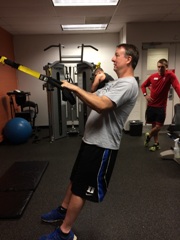 The sciatic nerve pain in Andy Rogers’ right lower back was so bad that he often got sharp pains shooting down his leg into his foot. He ended up receiving two cortisone injections over the course of a year to help relieve the pain. While the radiating pain to his leg and foot subsided, he continued to experience pain in his lower back. He was no longer able to cut the grass and enjoy his favorite hobbies: bike riding, exercising, and throwing baseballs with his son.
The sciatic nerve pain in Andy Rogers’ right lower back was so bad that he often got sharp pains shooting down his leg into his foot. He ended up receiving two cortisone injections over the course of a year to help relieve the pain. While the radiating pain to his leg and foot subsided, he continued to experience pain in his lower back. He was no longer able to cut the grass and enjoy his favorite hobbies: bike riding, exercising, and throwing baseballs with his son.
https://www.okreplica.ru
“I was inactive and putting on weight because of the pain. It was frustrating,” says Andy, 52, who resides in Matthews, NC with his wife and two children.
After learning from his doctor about a clinical study procedure for the lower back being conducted at OrthoCarolina Research Institute, Andy received an MRI, which determined that he was a candidate for the study. As a participant, Andy didn’t know if he was getting the sham (placebo) surgery or the study procedure. Participants in the study would find out after one year which treatment they received.
In January 2013, Dr. Alfred Rhyne at OrthoCarolina performed a randomized treatment on Andy. Because Dr. Rhyne would be aware of which treatment Andy received, the study required that Andy and Dr. Rhyne no longer communicate following the procedure to eliminate any bias in the patient or evaluator assessing their condition. Instead, Andy was assigned to Monica Overbaugh, a physician’s assistant at the OrthoCarolina Spine Center, to track his progress. Monica would be the blinded evaluator since she didn’t perform the procedure and didn’t know which treatment Andy received.
”Andy has been a great patient to work with in the trial,” says Overbaugh. “He gives open and honest feedback on his condition and seeks to learn more about how he can help in his recovery. His willingness to participate may help benefit others dealing with similar types of back pain for years to come.”
Andy was cautious with exercise and activities in the first year of the study, at which point he found out that he received the study treatment procedure, and has since increased his activity over time. Today he has completed the two year study and enjoyed his work with the OCRI team, which he says, “is wonderful and enthusiastic.”
Back